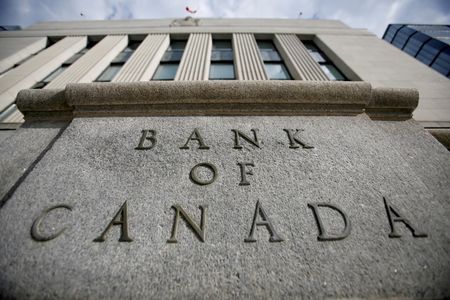
By Steve Scherer and David Ljunggren
OTTAWA (Reuters) -The Bank of Canada agreed that the need for further rate hikes would be determined by fresh economic data after it lifted rates to a 22-year high earlier this month, minutes from their policy meetings released on Wednesday showed.
Analysts said the tone of the notes made it clear the central bank was likely to raise rates again next month.
On June 7 the bank, which had been on hold since January, raised its overnight rate to 4.75%. In its summary of deliberations, or minutes, the governing council said growth and inflation had been stronger than expected.
“Members were of the view that with the resurgence in household spending growth, the pickup in consumer confidence, and the slowing in disinflationary momentum, monetary policy did not look to be sufficiently restrictive,” the minutes said.
The governing council discussed whether to signal a rate increase and then execute it in July, but decided there was enough data to act immediately.
The council then agreed to “assess the need for further policy rate increases based on the incoming data”. The council was concerned inflation could become stuck at a level materially above the bank’s 2% target.
Money markets see a roughly 72% chance that the bank will raise its policy rate by 25 basis points on July 12. [0#BOCWATCH]
“It’s all about the data … for now, we continue to look for a hike in July,” said Benjamin Reitzes, Canadian rates and macro strategist at BMO Capital Markets.
After the minutes were released, the Canadian dollar was trading at a nine-month high of 1.3162 to the greenback, or 75.98 U.S. cents, up 0.5% on the day.
“We don’t believe Canadian central bankers are done with rate hikes just yet … the key concerns that policymakers outlined in today’s summary of deliberations will likely still be unnerving in a few weeks,” said Tiago Figueiredo, a macro strategist at Desjardins.
Ahead of the June hike, statistics showed April annual inflation accelerated for the first time in 10 months to 4.4%, and first-quarter GDP rose 3.1% – versus the central bank’s 2.3% forecast – driven in part by consumer spending.
Since the June decision, Canada unexpectedly shed jobs in May, a possible first sign of a softening in the labour market. But the latest retail sales report for April and a May estimate issued on Wednesday suggest consumer spending remains strong.
The governing council said it expected second quarter growth would outpace the 1% annualized pace it forecast in April.
“Governing Council agreed that the economy remained clearly in excess demand and that the rebalancing of supply and demand was likely to take longer than previously expected”, the minutes said.
(Additional reporting by Fergal Smith in Toronto; Editing by Deepa Babington)






